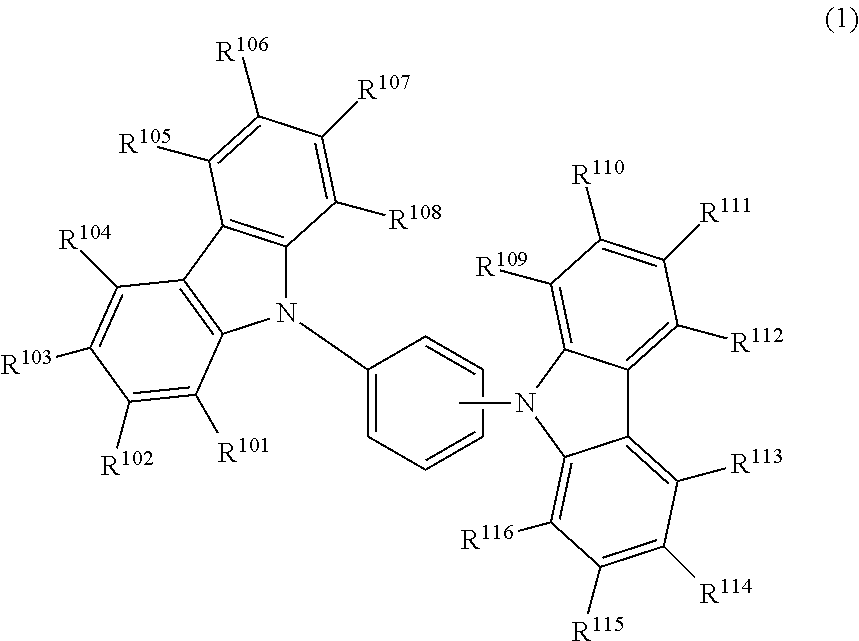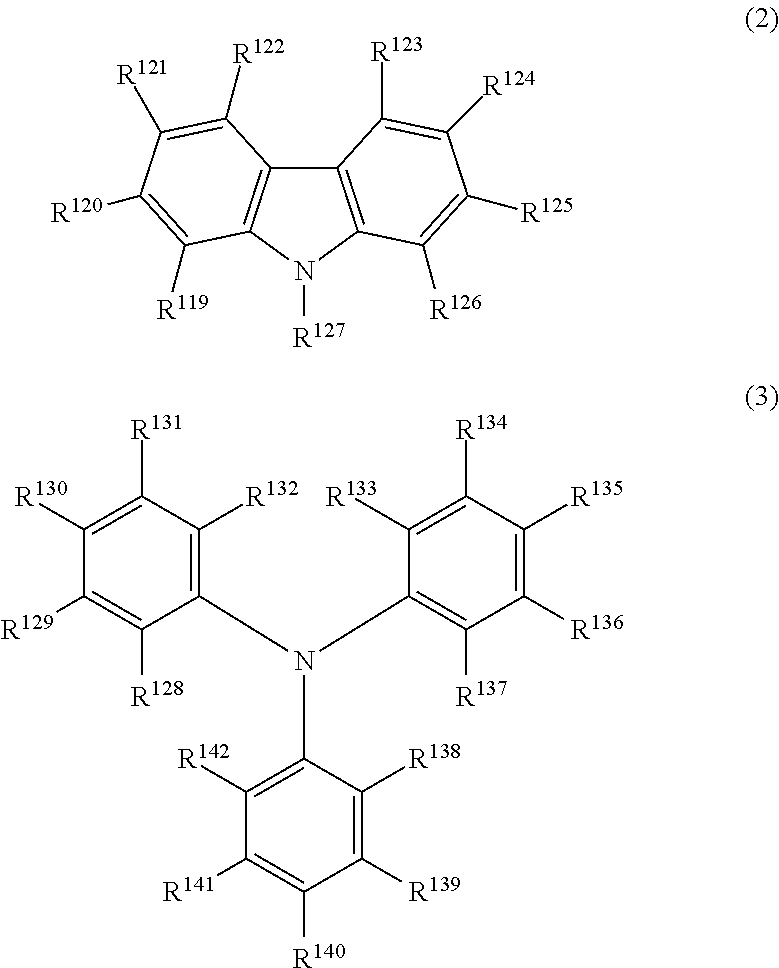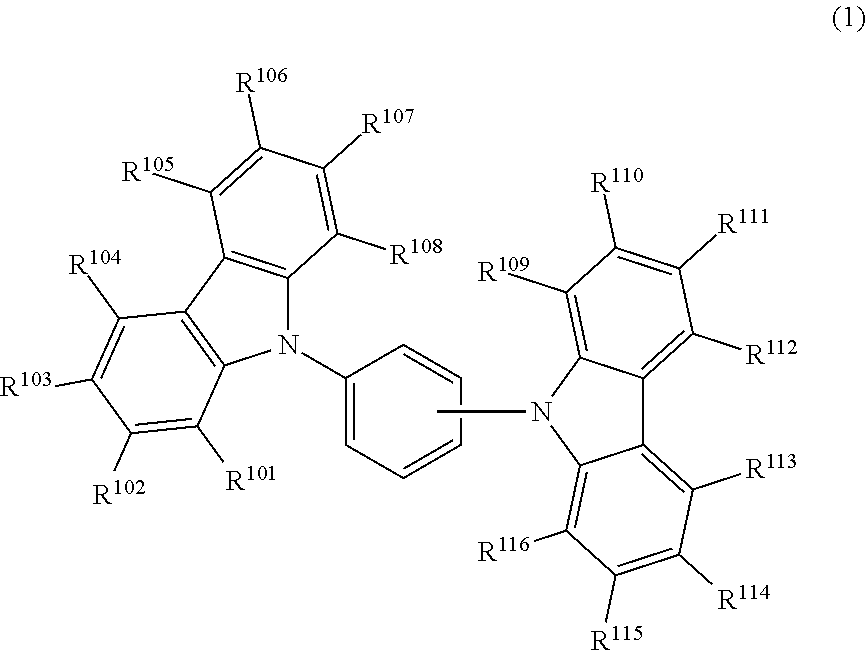Light emitting device material and light emitting device
a technology of light emitting device and material, which is applied in the direction of thermoelectric devices, triarylamine dyes, organic chemistry, etc., can solve the problems of insufficient luminance efficiency and device durable life, insufficient technology for achieving both high luminance efficiency and durable life, etc., to achieve sufficient durable life and high luminance efficiency
- Summary
- Abstract
- Description
- Claims
- Application Information
AI Technical Summary
Benefits of technology
Problems solved by technology
Method used
Image
Examples
synthesis example 1
[0108]Synthesis of Compound [1]
[0109]A mixed solution of 20.9 g of 3-bromocarbazole, 15.0 g of phenylcarbazole-3-boronic acid, 366 mg of palladium acetate, 300 mg of tris(2-methylphenyl)phosphine, 105 ml of a 2M aqueous potassium carbonate solution and 260 ml of dimethoxyethane was refluxed for 6 hours under a nitrogen flow. The solution was cooled to room temperature, and then extracted with 500 ml of toluene. The organic layer was washed with 100 ml of water twice, dried over magnesium sulfate, and then evaporated. The resultant concentrate was purified by silica gel column chromatography and then vacuum-dried to obtain 13.5 g of 9-phenyl-9H,9′H-3,3′-bicarbazole.
[0110]Next, a mixed solution of 13.5 g of 9-phenyl-9H,9H′-3,3′-bicarbazole, 3.0 g of 9-(3-chlorophenyl)-9H-carbazole, 62 mg of bis(dibenzylideneacetone)palladium, 47 mg of tri-t-butylphosphonium tetrafluoroborate, 7.2 mg of sodium tert-butoxide and 27 ml of o-xylene was heated and stirred for 6 hours under reflux under a n...
synthesis example 2
[0114]Synthesis of Compound [9]
[0115]A white solid was obtained by performing synthesis in the same manner as in Synthesis Example 1 except that 9-([1,1′-biphenyl]-4-yl)-3-(4,4,5,5-tetramethyl-1,3,2-dioxaborolane-2-yl)-9H-carbazole was used in place of phenylcarbazole-3-boronic acid.
[0116]1H-NMR analytical results of the resulting powder are as follows, and it was confirmed that the resulting white solid was a compound [9].
[0117]1H-NMR (CDCl3 (d=ppm)): 7.26-7.67 (16H, m), 7.68-7.91 (13H, m), 8.17 (2H, d, J=7.8 Hz), 8.26 (2H, d, J=7.3 Hz), 8.47 (2H, s).
[0118]The compound [9] was used as a light emitting device material after sublimation purification was performed at about 360° C. under a pressure of 1×10−3 Pa using an oil diffusion pump. The HPLC purity (area % at a measurement wavelength of 254 nm) was 99.7% before sublimation purification, and 99.9% after sublimation purification.
synthesis example 3
[0119]Synthesis of Compound [16]
[0120]A white solid was obtained by performing synthesis in the same manner as in Synthesis Example 1 except that 4-(diphenylamino)phenylboronic acid was used in place of phenylcarbazole-3-boronic acid.
[0121]1H-NMR analytical results of the resulting powder are, as follows, and it was confirmed that the resulting white solid was a compound [16].
[0122]1H-NMR (CDCl3 (d=ppm)): 7.00-7.90 (29H, m), 8.15-8.20 (3H, m), 8.33 (1H, s).
[0123]The compound [16] was used as a light emitting device material after sublimation purification was performed at about 290° C. under a pressure of 1×10−3 Pa using an oil diffusion pump. The HPLC purity (area % at a measurement wavelength of 254 nm) was 99.7% before sublimation purification, and 99.9% after sublimation purification.
PUM
 Login to View More
Login to View More Abstract
Description
Claims
Application Information
 Login to View More
Login to View More - R&D
- Intellectual Property
- Life Sciences
- Materials
- Tech Scout
- Unparalleled Data Quality
- Higher Quality Content
- 60% Fewer Hallucinations
Browse by: Latest US Patents, China's latest patents, Technical Efficacy Thesaurus, Application Domain, Technology Topic, Popular Technical Reports.
© 2025 PatSnap. All rights reserved.Legal|Privacy policy|Modern Slavery Act Transparency Statement|Sitemap|About US| Contact US: help@patsnap.com



